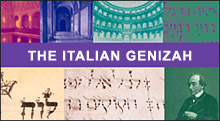
by Prof. Mauro Perani
Part 3: Research methodology
The first step is to inventory all the registers or volumes bound with leaves
of parchment Hebrew manuscripts. This work is actually very difficult considering
that some of the major archives contain more than 20 or 30 km. of shelves.
The second phase is the photocopying or microfilming, if possible, all the
folia, which are then sent to the Institute of Microfilmed Hebrew Manuscripts
at The Jewish National and University Library where they become part of the
collection.
The third phase is the identification of texts, cataloguing
and dating the fragments, reassembling the fragments belonging to the same
manuscript, and cataloguing them. Various data are also entered on cards:
measurements, type of parchment, color of the ink, ruling and pricking techniques,
type of script and the Italian or Latin titles (written by Italian archivists
or notaries), and date of the records contained in the register bound by the
manuscript.
In some cases the manuscripts were detached from the registers
and restored long ago or more recently. The detachment enables the fragment
to be examined more closely, best if the text is preserved in both the inner
and the outer side of the cover.
After cataloguing the small collections, more comprehensive
catalogues embracing all the archives in the same town or area will be published.
In these, all the fragments belonging to the same manuscript can be put together.
The final aim of this project is the publication of a single complete catalogue
of all these disiecta membra found in Italy, which would enrich the precious
treasury of medieval Hebrew manuscripts kept in libraries throughout the world.
Part 1: The discovery
| Part 2 Background information
|
Part 3: Research methodology | Part 4: Content
of findings
 |
[1] The most significant
sample is the finding of two sheets from the same manuscript containing
the Sefer Mordekay with commentaries, one of them was found in Modena,
while the other one in the Archives of the Curia in Mantua. |



